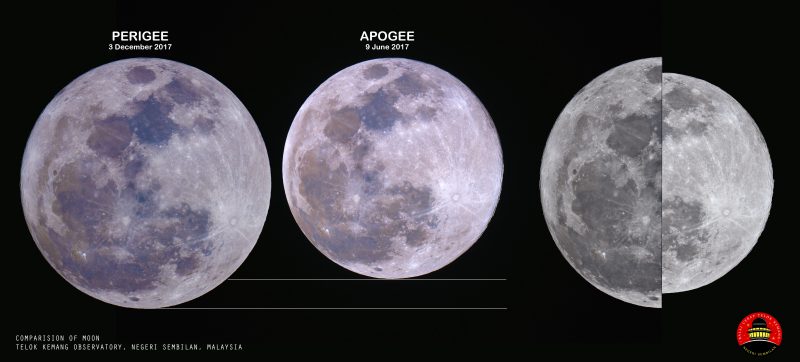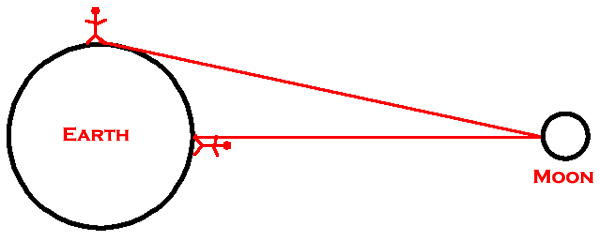
Above: Stefano Sciarpetti created this composite image of a full supermoon (full moon closest to Earth) with a micro-moon (full moon farthest from Earth). It was the Astronomy Picture of the Day for January 21, 2014.
On both May 6 and 7, 2020, the moon will appear round and full to the eye as it lights up the night from dusk until dawn. This May full moon is 2020’s third and final full supermoon, and it’s also the third-closest, third-biggest and third-brightest supermoon of 2020. The first supermoon of 2020 was on March 9. The second was on the night of April 7-8; it was April when the full moon and lunar perigee (the moon’s closest point to Earth in its monthly orbit) aligned most closely for the year 2020, giving us the biggest and brightest full supermoon of the year.
This May 2020 supermoon isn’t the biggest or brightest, but it is, by definition, a supermoon: a full moon or new moon within 90% of its closest approach to Earth. That definition isn’t official in any sense, but it’s become engrained in popular culture.
In North America – according to the popular culture of earlier times, what we now call folklore, or skylore – we’ll also call this May 2020 supermoon by the names the Flower Moon, Planting Moon or Milk Moon. It’ll shine in front of the constellation Libra the Scales.
Moon’s present position in front of the constellations of the zodiac via Heavens-Above
Full moon supermoons in 2020:
March 9, 2000: 222,081 miles (357,404 km)
April 8, 2020: 221,851 miles (357,035 km)
May 7, 2020: 224,429 miles (361,184 km)
This month, the moon turns precisely full on May 7, at 10:45 UTC. Although the full moon happens at the same instant worldwide, the clock reads differently by time zone. At North American and United States time zones, the moon reaches the crest of its full phase on May 7, at 7:45 a.m. ADT, 6:45 a.m. EDT, 5:45 a.m. CDT, 4:45 a.m. MDT, 3:45 a.m. PDT, 2:45 a.m. AKDT and 12:45 a.m. HST.
The moon always appears full to the eye for two to three days in a row. Twelve hours before and after this May full moon, the moon is still 99.6% illuminated by sunshine (according to The Moon Tonight).
Meanwhile, astronomers regard the moon as full at the instant that it’s exactly 180 degrees opposite the sun in ecliptic longitude. In other words, the moon-sun elongation at full moon equals 180 degrees. Click on The Moon Tonight to find out the present moon-sun elongation, remembering that a positive number refers to a waxing (increasing) moon and a negative number to a waning (shrinking) moon.
From one month to the next – unless you’re a very experienced observer – you’re not likely to discern a size difference between full moons.
On the other hand, full supermoons might be noticeably brighter. A full moon at perigee (closest point to Earth in the moon’s monthly orbit) is about 15 percent brighter than a full moon at its average distance from Earth, and about 30 percent brighter than a full moon at apogee (farthest point from Earth in the moon’s monthly orbit). This May 2020 supermoon, though … it’ll be a bit brighter than non-supermoons, but perhaps not noticeably so.
So it’ll be a fairly ordinary-looking moon that ascends in your sky around sunset on May 6 and 7, 2020 and that shines brightly in your sky all night on these nights. And indeed some skywatchers object to the term supermoon, because the size differences of full moons aren’t readily discernible to the eye. That’s true. They aren’t. On the other hand, few – if any – sky gazers can tell the exact moment of a 100-percent-illuminated full moon with the eye, either. And yet astronomical almanacs give the full moon times to the minute. A photo finish to determine the winner of a contest doesn’t make the event any less exciting.

Here’s a comparison between the December 3, 2017, full moon at perigee (closest to Earth for the month) and the year’s farthest full moon in June 2017 at apogee (farthest from Earth for the month) by Muzamir Mazlan at Telok Kemang Observatory, Port Dickson, Malaysia. More photos of the December 2017 supermoon.
The full moon’s distance only changes incrementally from month to month, as we show on the listing below. For instance, a full moon that aligns with lunar apogee (the moon’s most distant point in its orbit) never precedes or follows a full moon aligning with perigee. In fact, the smallest full moon of the year on October 31, 2020, comes exactly 7 lunar months (7 full moons) after the year’s biggest full moon on April 8, 2020:
Full moon distances:
April 8, 2020: 221,851 miles (357,035 km)
May 7, 2020: 224,429 miles (361,184 km)
June 5, 2020: 229,285 miles (368,999 km)
July 5, 2020: 235,586 miles (379,140 km)
August 3, 2020: 242,254 miles (389,871 km)
September 2, 2020: 248,051 miles (399,200 km)
October 1, 2020: 251,747 miles (405,147 km)
October 31, 2020: 252,380 miles (406,166 km)
Source: The Moon Tonight
And guess what? Exactly 7 lunar months (7 full moons) after the year’s farthest and smallest full moon on October 31, 2020, it’ll be next year’s closest and largest full moon on May 26, 2021! Moreover, this May 2021 full moon will pass right through the Earth’s dark umbral shadow, to stage the first total lunar eclipse since January 21, 2019.

Here’s something fun to think about. Illustration via Phil Plait. Phil explains: “The guy at the top of the Earth in the diagram sees the moon on his horizon, and the guy on the side of the Earth sees it overhead. But you can tell the distances aren’t the same: the moon is closer to the guy who sees it as overhead (by an amount roughly equal to the Earth’s radius).” Cool!
Bottom line: Enjoy the last full moon supermoon of the year on May 6 and 7, 2020. The moon turns precisely full on May 7 at 10:45 UTC; translate UTC to your time.
Read more: What is a supermoon?
from EarthSky https://ift.tt/2L13r7H

Above: Stefano Sciarpetti created this composite image of a full supermoon (full moon closest to Earth) with a micro-moon (full moon farthest from Earth). It was the Astronomy Picture of the Day for January 21, 2014.
On both May 6 and 7, 2020, the moon will appear round and full to the eye as it lights up the night from dusk until dawn. This May full moon is 2020’s third and final full supermoon, and it’s also the third-closest, third-biggest and third-brightest supermoon of 2020. The first supermoon of 2020 was on March 9. The second was on the night of April 7-8; it was April when the full moon and lunar perigee (the moon’s closest point to Earth in its monthly orbit) aligned most closely for the year 2020, giving us the biggest and brightest full supermoon of the year.
This May 2020 supermoon isn’t the biggest or brightest, but it is, by definition, a supermoon: a full moon or new moon within 90% of its closest approach to Earth. That definition isn’t official in any sense, but it’s become engrained in popular culture.
In North America – according to the popular culture of earlier times, what we now call folklore, or skylore – we’ll also call this May 2020 supermoon by the names the Flower Moon, Planting Moon or Milk Moon. It’ll shine in front of the constellation Libra the Scales.
Moon’s present position in front of the constellations of the zodiac via Heavens-Above
Full moon supermoons in 2020:
March 9, 2000: 222,081 miles (357,404 km)
April 8, 2020: 221,851 miles (357,035 km)
May 7, 2020: 224,429 miles (361,184 km)
This month, the moon turns precisely full on May 7, at 10:45 UTC. Although the full moon happens at the same instant worldwide, the clock reads differently by time zone. At North American and United States time zones, the moon reaches the crest of its full phase on May 7, at 7:45 a.m. ADT, 6:45 a.m. EDT, 5:45 a.m. CDT, 4:45 a.m. MDT, 3:45 a.m. PDT, 2:45 a.m. AKDT and 12:45 a.m. HST.
The moon always appears full to the eye for two to three days in a row. Twelve hours before and after this May full moon, the moon is still 99.6% illuminated by sunshine (according to The Moon Tonight).
Meanwhile, astronomers regard the moon as full at the instant that it’s exactly 180 degrees opposite the sun in ecliptic longitude. In other words, the moon-sun elongation at full moon equals 180 degrees. Click on The Moon Tonight to find out the present moon-sun elongation, remembering that a positive number refers to a waxing (increasing) moon and a negative number to a waning (shrinking) moon.
From one month to the next – unless you’re a very experienced observer – you’re not likely to discern a size difference between full moons.
On the other hand, full supermoons might be noticeably brighter. A full moon at perigee (closest point to Earth in the moon’s monthly orbit) is about 15 percent brighter than a full moon at its average distance from Earth, and about 30 percent brighter than a full moon at apogee (farthest point from Earth in the moon’s monthly orbit). This May 2020 supermoon, though … it’ll be a bit brighter than non-supermoons, but perhaps not noticeably so.
So it’ll be a fairly ordinary-looking moon that ascends in your sky around sunset on May 6 and 7, 2020 and that shines brightly in your sky all night on these nights. And indeed some skywatchers object to the term supermoon, because the size differences of full moons aren’t readily discernible to the eye. That’s true. They aren’t. On the other hand, few – if any – sky gazers can tell the exact moment of a 100-percent-illuminated full moon with the eye, either. And yet astronomical almanacs give the full moon times to the minute. A photo finish to determine the winner of a contest doesn’t make the event any less exciting.

Here’s a comparison between the December 3, 2017, full moon at perigee (closest to Earth for the month) and the year’s farthest full moon in June 2017 at apogee (farthest from Earth for the month) by Muzamir Mazlan at Telok Kemang Observatory, Port Dickson, Malaysia. More photos of the December 2017 supermoon.
The full moon’s distance only changes incrementally from month to month, as we show on the listing below. For instance, a full moon that aligns with lunar apogee (the moon’s most distant point in its orbit) never precedes or follows a full moon aligning with perigee. In fact, the smallest full moon of the year on October 31, 2020, comes exactly 7 lunar months (7 full moons) after the year’s biggest full moon on April 8, 2020:
Full moon distances:
April 8, 2020: 221,851 miles (357,035 km)
May 7, 2020: 224,429 miles (361,184 km)
June 5, 2020: 229,285 miles (368,999 km)
July 5, 2020: 235,586 miles (379,140 km)
August 3, 2020: 242,254 miles (389,871 km)
September 2, 2020: 248,051 miles (399,200 km)
October 1, 2020: 251,747 miles (405,147 km)
October 31, 2020: 252,380 miles (406,166 km)
Source: The Moon Tonight
And guess what? Exactly 7 lunar months (7 full moons) after the year’s farthest and smallest full moon on October 31, 2020, it’ll be next year’s closest and largest full moon on May 26, 2021! Moreover, this May 2021 full moon will pass right through the Earth’s dark umbral shadow, to stage the first total lunar eclipse since January 21, 2019.

Here’s something fun to think about. Illustration via Phil Plait. Phil explains: “The guy at the top of the Earth in the diagram sees the moon on his horizon, and the guy on the side of the Earth sees it overhead. But you can tell the distances aren’t the same: the moon is closer to the guy who sees it as overhead (by an amount roughly equal to the Earth’s radius).” Cool!
Bottom line: Enjoy the last full moon supermoon of the year on May 6 and 7, 2020. The moon turns precisely full on May 7 at 10:45 UTC; translate UTC to your time.
Read more: What is a supermoon?
from EarthSky https://ift.tt/2L13r7H

Aucun commentaire:
Enregistrer un commentaire